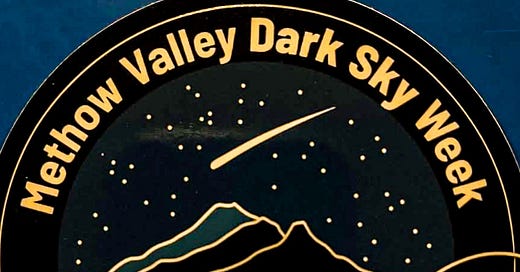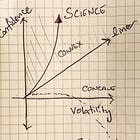Hey Friends!
A short while ago we gave a public lecture at the Cosmic Microwave Background at Ryzo Wines for the Methow Valley Dark Skies Week.
I wanted to emphasize the gory details. Not that I expected the audience to become precision cosmologists within the hour. I wanted to demonstrate the scope and scale of what we’ve collectively learned. I wanted the audience to know that we weren’t just tossing big ideas around without the mountains of data required to justify them.
It was a pretty ambitious talk.
I’m writing a series of posts here to compliment that talk. I’ll expand the logic by breaking the talk into multiple sections. I’ll also share some resources where you can learn more. Today we’re starting with a brief introduction.
Sean
Why are we here?
That’s a bit of a loaded question. We can unloaded it by splitting it into complementary halves: Why are we here? and How did we get here?
Why? is personal. It’s internal. Why is a question only you can answer for yourself. You can offload it to religion or folklore, but to get an answer you’ll ultimately have to make a decision to accept it. You and your neighbor can have two distinct answers to this question without any contradiction.
How? is empirical. It’s external. How is a question you absolutely cannot answer by yourself. You need to study the world around you - or in this case, the Universe. You and your neighbors - assuming you are rational beings - must ultimately agree based on the data gathered. How? - being driven by data - necessarily includes ignorance and ambiguity. You’ll never get a complete answer to How? What’s important is that ignorance and ambiguity are quantified. We know what we know up to a known level of precision.
Being able to disentangle Why? from How? is both a choice and a skill, and that distinction has permeated the modern age.
How? is the methodology of Science. In this case we’re asking how the Universe conspired to put us here. We will gloss over details. In this series we’re not focused on human history, evolutionary biology or even the formation of the Earth. The Science of Cosmology explores how the Universe went from the Big Bang until its present state. It attempts to predict the structure and motion of entire Universe.
My job over the next few posts is to illuminate just a portion of what we know about the history of the Universe.
How did I get here?
As I discussed in the talk, I'm not a real cosmologist. My work in Cosmology has been limited to how it interfaces with phenomenological models of particle physics and string theory. The story of how I got involved with Cosmology and how I left the field is a good case study in how Science works in practice.
Early career academics typically publish where the action is. I began the work that would eventually become my thesis by looking at phenomenological models of early universe cosmology in based in String Theory, and connecting them to the observable infrastructure of particle physics.
In 2012, after the Higgs was finally spotted at the Large Hadron Collider, all eyes turned toward Weak Scale Supersymmetry. The beam line shut down so that the experiments - such as CMS and ATLAS - could reconfigure their detectors to look for any signs of new physics.
At the same time, new generations of dark matter direct detection experiments were actively collecting data. Based on popular models of new particle physics, it was expected that dark matter could be created directly at the LHC. The prospect of detecting them both directly and indirectly at the same time was very exciting.
The Planck satellite was also poised to update our understanding of the earliest moments of the Universe. There was also strong reason to believe that the new physics at the LHC could be tied to the Planck data.
In short, 2012 was a very optimistic time to be a high energy physicist.
Wrongly, as things turned out. None of the revolutionary expectations were borne out. Qualitatively, not much has changed about our understanding of the Universe since our confirmation of the Higgs’ existence. As a result, not much work needed to be done. My attention drifted elsewhere1.
What is Cosmology, exactly?
Cosmology is not the study of individual stars or galaxies2. That’s Astronomy. Cosmology involves the collective behavior of all known galaxies. Astronomy is to study of water molecules as Cosmology is to fluid dynamics.
It is the study of where the Universe came from, and where it is going.
The primary observational signal in Cosmology is light3. Light has a finite speed. Hence, the further an object is from us, the older its light is when it reaches us.
The sun we see is eight minutes old. The light from the Andromeda Galaxy is 2.5 million years old. In Cosmology, we are literally looking at photographs of the Universe at different points in its history.
Present observations suggest that the universe is just shy of 14 billion years old. We have observations of light from when the Universe was 380,000 years young. The James Webb Space Telescope appears to have observed a galaxy formed before the Universe’s 300 millionth birthday4. We have observations of relatively modern galaxies, and everything in between.
Typically, cosmologists study the statistical properties of a large collection of galaxies at various distances. These studies are then used to model how the elements in our Universe formed, how and when stars and galaxies formed and what their general distribution and motion throughout the Universe is today. These details can also be used to make predictions for what happens next5.
What’s to Come?
Next time, we’ll give a quick tour of our small corner of the Universe before jumping into some of astrophysical signposts like Cepheid Variables and Type Ia supernovae. We’ll also explore the physical connection between temperature and electromagnetic radiation, and what that means studying the Universe. We’ll learn how we know the universe started with a bang, and from that explosion how the first elements were formed. Finally, we’ll see how ripples of the primordial explosion got imprinted on the distribution of galaxies as we see them today and in the past, a remarkable verification of our models with outstanding quantitative precision.
If you’re a young academic, you might consider working directly on what you’re most interested in. Like it or not, you’re going to eventually end up there. Of course, whether you’ll get paid to work directly on that material is another matter. You can read more about this transition of mine here:
Although search for a specific class of stars might well count as a contribution to Cosmology.
Other potential signals include the primordial abundances of neutrini and gravity waves.
Not that the concept of a year or a “birthday” made any sense before the Earth was formed and orbiting the sun. What’s interesting about this galaxy, named JADES-GS-z14-0, is that it appears a bit earlier than our astrophysical models for star and galaxy formation suggested.
For a fun and very readable account of how the universe might end, check out Katie Mack’s book The End of Everything.





